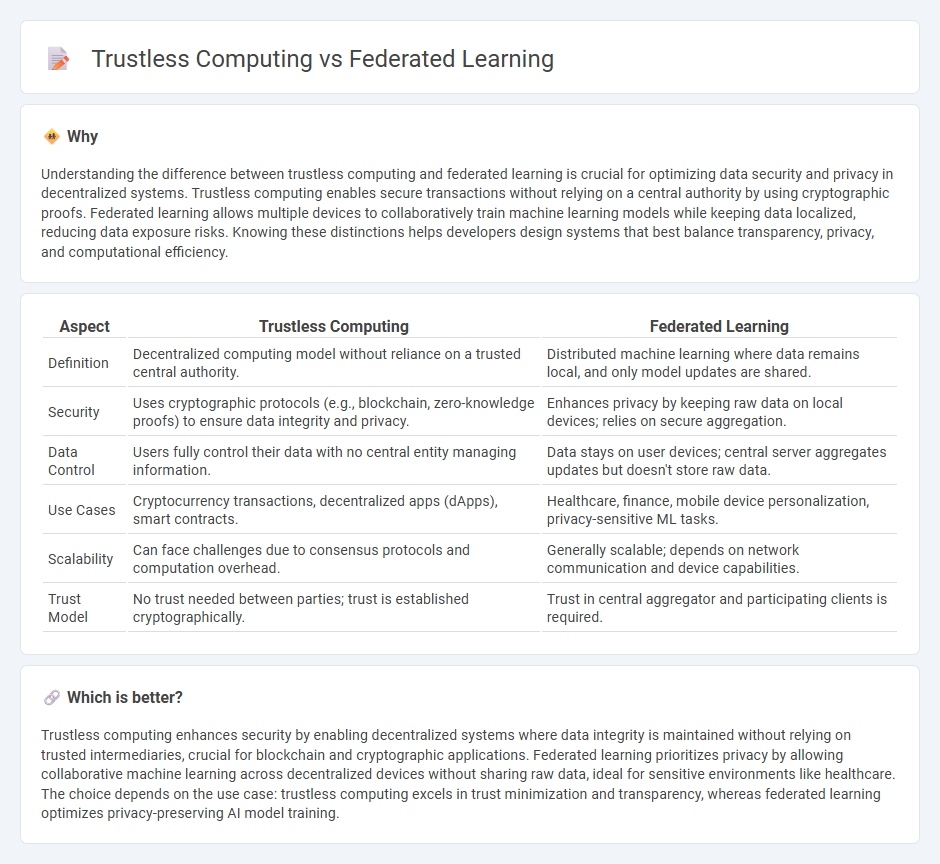
Trustless computing enables secure data processing without relying on a central authority by using blockchain and cryptographic protocols, ensuring transparency and immutability. Federated learning allows multiple devices to collaboratively train AI models while keeping data localized, preserving privacy and reducing data transfer. Explore more about how these innovative technologies are transforming data security and machine learning.
Why it is important
Understanding the difference between trustless computing and federated learning is crucial for optimizing data security and privacy in decentralized systems. Trustless computing enables secure transactions without relying on a central authority by using cryptographic proofs. Federated learning allows multiple devices to collaboratively train machine learning models while keeping data localized, reducing data exposure risks. Knowing these distinctions helps developers design systems that best balance transparency, privacy, and computational efficiency.
Comparison Table
| Aspect | Trustless Computing | Federated Learning |
|---|---|---|
| Definition | Decentralized computing model without reliance on a trusted central authority. | Distributed machine learning where data remains local, and only model updates are shared. |
| Security | Uses cryptographic protocols (e.g., blockchain, zero-knowledge proofs) to ensure data integrity and privacy. | Enhances privacy by keeping raw data on local devices; relies on secure aggregation. |
| Data Control | Users fully control their data with no central entity managing information. | Data stays on user devices; central server aggregates updates but doesn't store raw data. |
| Use Cases | Cryptocurrency transactions, decentralized apps (dApps), smart contracts. | Healthcare, finance, mobile device personalization, privacy-sensitive ML tasks. |
| Scalability | Can face challenges due to consensus protocols and computation overhead. | Generally scalable; depends on network communication and device capabilities. |
| Trust Model | No trust needed between parties; trust is established cryptographically. | Trust in central aggregator and participating clients is required. |
Which is better?
Trustless computing enhances security by enabling decentralized systems where data integrity is maintained without relying on trusted intermediaries, crucial for blockchain and cryptographic applications. Federated learning prioritizes privacy by allowing collaborative machine learning across decentralized devices without sharing raw data, ideal for sensitive environments like healthcare. The choice depends on the use case: trustless computing excels in trust minimization and transparency, whereas federated learning optimizes privacy-preserving AI model training.
Connection
Trustless computing enables secure data processing without relying on a central authority, which complements federated learning by allowing decentralized model training across multiple devices while preserving data privacy. Federated learning leverages trustless protocols to aggregate local machine learning models, enhancing collaborative intelligence without exposing raw data. This synergy improves data security and model accuracy in distributed AI systems.
Key Terms
Data Privacy
Federated learning enables decentralized model training by keeping raw data on local devices, significantly minimizing privacy risks associated with centralized data storage. Trustless computing leverages cryptographic techniques like secure multi-party computation and blockchain to ensure data integrity and confidentiality without requiring mutual trust between parties. Explore the nuances of federated learning and trustless computing to deepen your understanding of cutting-edge data privacy solutions.
Decentralization
Federated learning enables decentralized data processing by allowing multiple devices to collaboratively train machine learning models without sharing raw data, preserving privacy while reducing central server dependence. Trustless computing leverages blockchain and cryptographic protocols to execute computations securely across distributed nodes, eliminating the need for a trusted central authority and enhancing transparency. Explore how these cutting-edge decentralized technologies transform data security and collaborative innovation.
Consensus Mechanism
Federated learning enhances data privacy by enabling decentralized model training without sharing raw data, relying on secure aggregation to maintain confidentiality. Trustless computing uses consensus mechanisms like Proof of Work or Proof of Stake to validate transactions and enforce system integrity in decentralized networks. Explore further to understand how consensus algorithms impact privacy and efficiency in these technologies.
Source and External Links
What Is Federated Learning? | IBM - Federated learning is a decentralized machine learning approach where each node trains a global model using its local data and a central server aggregates updates, preserving data privacy by keeping sensitive information on-device.
What is federated learning? - Federated learning enables multiple parties to collaboratively train AI models by locally updating a shared model on private data, then encrypting and aggregating these updates in the cloud without sharing raw data.
Federated learning - Wikipedia - Federated learning trains machine learning models on decentralized, heterogeneous local datasets across multiple clients by exchanging model parameters instead of raw data to produce a global shared model.
 dowidth.com
dowidth.com